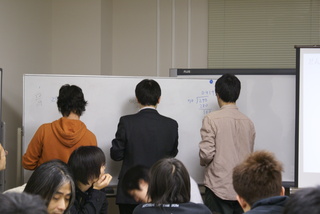Creative Café Vol 7 Grasp it with an approximate number 1/3pict
2010.09.29
Fractions and infinite cycling decimals
Nohara:today's theme is "approximate numbers" or "round numbers". It's not just to talk about maths and numbers, but how culture has emerged from looking at them, and how they are part of human consciousness, our way of thinking and ideas. This is not just the territory of mathematics but also art; I'm looking forward to trying to think about "approximate numbers" from a flexible perspective.
Murakami:with approximate numbers, round numbers, I think everyone will have learnt these in arithmetic at primary school but they are the bane of teachers' lives. They are the most difficult thing. Because there is no answer to some of these approximate numbers. If we think of the primary schoolteacher, even though they are approximate numbers, he wants to somehow teach as if we can know these things accurately. So let's talk about approximate mathematics and exact mathematics. For instance, if we calculate 1/7, 0.142857142857142857 repeats. Over and over again. This is the truth, if you write down the calculations you will understand, but it's troublesome so really 1/3 is about as far as you want to go. If you calculate 1/3, 3 emerges, if you subtract 9, the same division (1/3) emerges again. With fractions if you do this, the same pattern emerges from somewhere, and repeats further below. If you have a calculation manual you will understand. People who thought division was really interesting at primary school will have met this phenomenon somewhere I'm sure.
Tsuda:if we do this, can we say that it is a repetitive division?
Murakami:yes, that's so. However you don't know how many figures it will take, maybe be several million but definitely it will repeat.
Tsuda:even with music, Baroque music and so on repeats even when delicately drifting away.
Murakami:but, repetition, as I will explain a little more in a moment, if you convert fractions to decimals, the repetition continues infinitely. But if you express a fraction as one number divided by another, it is all other very suddenly. There is no repetition.For example, if we say 1/3, the answer can be formed just by 1 and 3. But if we express it as a decimal 0.3333.... continues to infinity. If you think about infinity, you may start feeling rather distant but if we say one third, is something we can identify with (laughter). If we do it in reverse, it's a fraction continuing to infinity but if you look closely and see the repeating patterns, this is definitely a fraction comprised of integers. Wherever we say, for instance I number we don't know well such as x=0.142857142857142857...... we get still see that it repeats to infinity. This is a number that repeats after six figures. (Murakami draws some illustrations of the repetitive pattern and how it can be related back to 1/7; and how a mathematical proof allows a repetitive decimal to be related back to the original fraction)
that beauty and strangeness of mathematical infinity

Murakami:0.41421356......what is this? Does anyone know? Yes
M:square root of 2 minus 1.
Murakami:Ah: correct, it is the square root of 2 minus 1. I would like Japanese people to know this but if I attach the label person to the head, people would see it as a person. We can say let's remember in this way but that's Japan's traditional expectation. Of course currently, if there is a computer to hand that is the quickest way of working out the square root of 2. You'll also find out very quickly by consulting Wikipedia. However this number, in contrast to the previous fractions, never repeats itself. Maybe you learnt that at high school. You can't express the square of two as a fraction. In other words it is not a rational number. I think you learnt that somewhere. Perhaps at the university entrance exam if this problem features, there are many who may not be able to solve it but do you know the proof? It's a reduction to absurdity. Perhaps this is reawakening painful experiences in the past for some people. In any case the square root of 2, is an irrational number: irrational numbers are when there is no cycling of numbers when you express it as a decimal. Therefore what should we say, like a dirty number; if you express it is a decimal perhaps it looks like it becomes dirty but if I write it as a continuous string of numbers then it is much prettier.
if I say "divide by 1, add 2 and divide by 1, and so on", then there is a cycle. If you look at the reference in Wikipedia(http://ja.wikipedia.org/wiki/2%E3%81%AE%E5%B9%B3%E6%96%B9%E6%A0%B9) and look at the extremity of the continuous fraction, it becomes really quite a pretty shape doesn't it? The "..." in this area is a bit difficult to understand but this is firstly the approximate number. The very first number is close to 0.5, the next to 0.4, then if we proceed in order to 0.415833... we gradually get closer and closer to the real value of square root of 2 -1. In mathematics, to proceed in this way-to grasp the approximate number and then to check it against reality- is quite common. It's called extrapolating to infinity. If I put it more simply, although we first grasp the number only approximately, gradually the area of uncertainty is narrowed, and we can focus on finally obtaining one individual number. With this perhaps some of you are remembering a dislike for differential calculus in your university first year? Ah, no reaction. Maybe you've forgotten completely about things you hated (laughter). You must have done it or maybe not??

